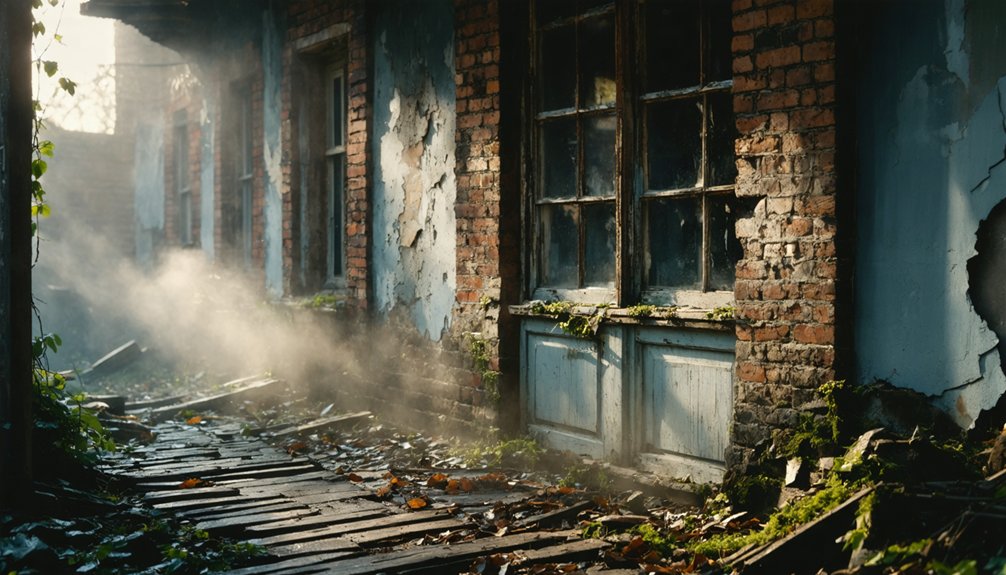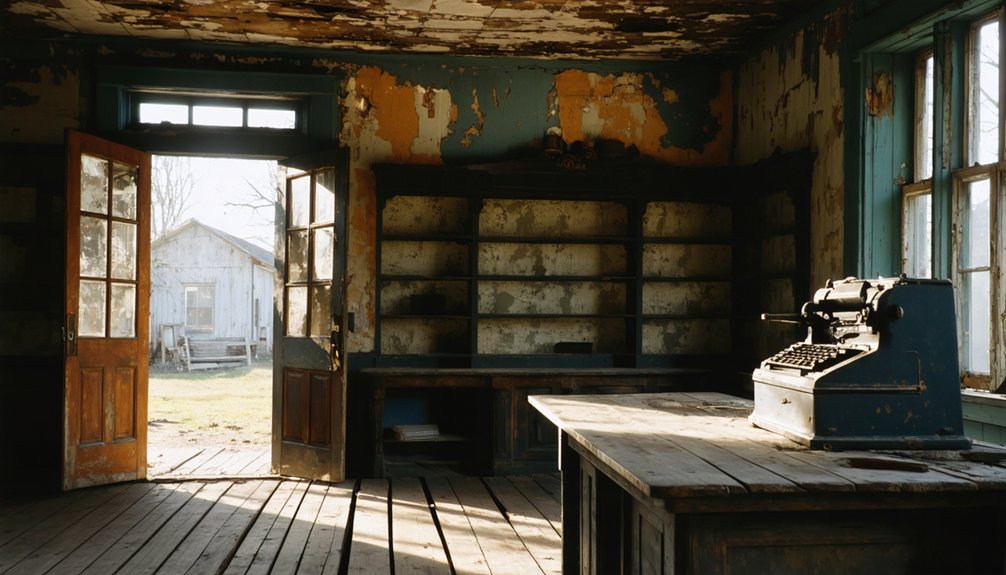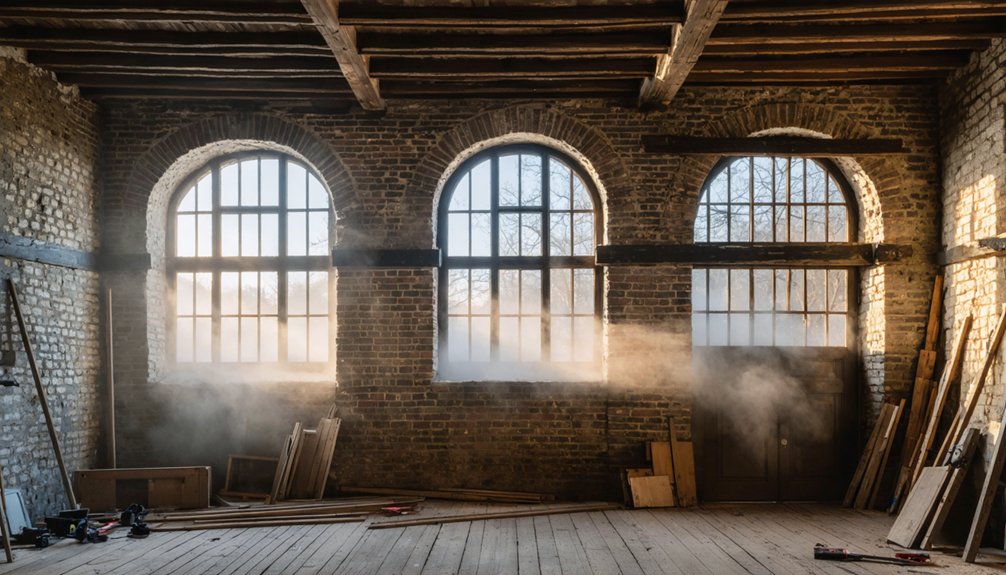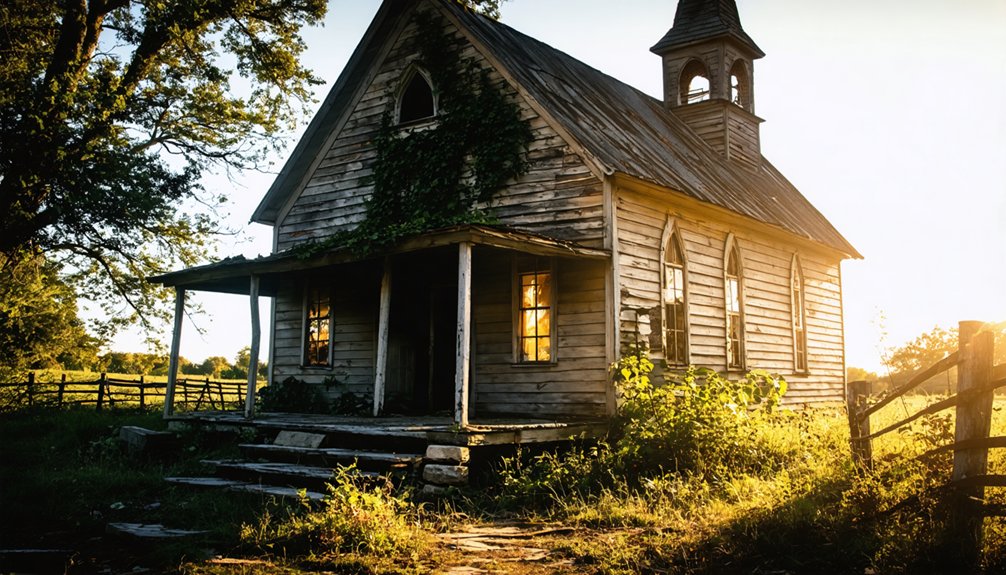To capture haunting colonial ghost towns effectively, scout historical sites using archival records and pack a full-frame camera with wide-angle and prime lenses. Shoot during golden hour for dramatic shadows or use 15-30 second exposures for starlit ruins. Create depth with leading lines along weathered structures and consider black-and-white conversion with selective color to emphasize texture. Always secure permissions, wear protective gear, and respect historical artifacts. These techniques will transform your documentation into compelling visual narratives.
Key Takeaways
- Use wide-angle lenses (12-24mm) to capture expansive architectural layouts and fast primes for low-light details in abandoned structures.
- Shoot during golden hour for dramatic shadow play across ruins and position to highlight colonial architectural elements with angled light.
- Convert images to black and white with selective color techniques to emphasize texture and create visual hierarchy.
- Secure permissions before entering historic sites and wear protective gear while evaluating structural integrity to ensure safety.
- Create atmosphere with 15-30 second exposures at f/1.4-f/4 to capture starlight without trails while illuminating colonial remnants.
Finding and Researching Authentic Colonial Ghost Towns
While colonial ghost towns offer fascinating windows into America’s past, locating and authenticating these abandoned settlements requires methodical research and careful documentation.
Begin by consulting historical maps spanning multiple decades, noting how settlements evolved or disappeared over time. Cross-reference land records with genealogical databases to identify original property boundaries and resident locations, establishing the town’s authentic footprint.
Tracing colonial ghost towns requires layering historical maps with land records to reveal the authentic spatial footprint of vanished communities.
For meaningful ghost town exploration, verify sites through official historic registries that confirm colonial origins and historical significance. Leverage local historical societies, archives, and published sources—newspapers, census data, church records—to construct a timeline of the town’s establishment and eventual abandonment. The State Archives of Florida offers extensive resources for researching ghost towns without requiring special permissions or appointments for access.
Focus on settlements with remaining physical evidence or documented connection to colonial economic activities like mining, agriculture, or trade routes. Many ghost towns preserve their history through annual re-enactments similar to the Bannack Days celebration in Montana, providing valuable insight into daily colonial life.
Essential Camera Gear for Documenting Historic Ruins
Documenting colonial ghost towns effectively requires specialized photographic equipment that balances technical capability with practical field considerations. Your camera types should prioritize large sensors—full-frame or APS-C systems offer superior low-light performance essential for capturing shadowy interiors and weathered structures.
Choose mirrorless or DSLR bodies with RAW capabilities to maximize post-processing flexibility in challenging lighting conditions.
Lens choices greatly impact your storytelling capacity:
- Wide-angle lenses (12-24mm) capture expansive architectural layouts and establish context
- Fast prime lenses (35-50mm) excel in low-light environments while delivering sharp detail of artifacts
- Macro lenses reveal intricate textures and inscriptions often overlooked in decaying colonial remnants
Don’t underestimate stabilization gear—a sturdy tripod with an L-bracket enables long exposures and perspective control, particularly when using filters to balance harsh lighting contrasts in these haunting historical spaces. Always pack flashlights and headlamps to reveal hidden details in dark corners when natural light fails to penetrate deep interiors. Consider carrying a selection of ND grad filters to help control exposure and add moody atmosphere to your images rather than relying solely on post-processing.
Mastering Light: Golden Hour and Night Photography Techniques
When photographing colonial ghost towns, you’ll discover that sunset creates dramatic shadow play across weathered structures, transforming ordinary ruins into mysterious silhouettes with elongated proportions.
Position yourself to capture architectural elements like doorways or collapsed walls as they intersect with the low-angled golden hour light, creating compositional tension between solid forms and ephemeral shadows. The warm tones of golden hour photography evoke a nostalgic quality that perfectly complements the historical nature of abandoned colonial sites. Consider using a reflector to create fill light when capturing portraits against these historical backdrops.
As daylight fades completely, you can disclose an entirely different character of these historical sites through starlight exposure techniques, where patient exposure times of 20-30 seconds will reveal celestial elements above these abandoned settlements, connecting terrestrial history to cosmic timelessness.
Sunset Shadow Play
As the sun descends toward the horizon, ghost town photography transforms into a magnificent opportunity for shadow play that reveals architectural details often missed during midday explorations.
The low-angle golden hour light creates dramatic shadow elongation across weathered structures, exposing textures and architectural nuances through side-lighting techniques. For those seeking to enhance the mood, shadows can dramatically alter the emotional resonance of colonial remnants, transforming ordinary ruins into haunting visual narratives. Side-lighting techniques create remarkable depth and dimension that highlight the weathered textures of abandoned buildings.
Position yourself perpendicular to the sun to maximize definition in these ephemeral moments:
- Manipulate angles by shooting from lower positions to extend shadows across abandoned thoroughfares
- Create interactive silhouettes by placing yourself or companions within the frame to interact with building shadows
- Experiment with silhouettes by positioning recognizable colonial structures against the bright background sky
This transitory period offers mere minutes of ideal conditions, so scout locations beforehand to capitalize on the interplay between fading light and historical remnants.
Starlight Exposure Magic
The transformation of colonial ghost towns under starlight presents a photographic canvas unlike any daytime counterpart, requiring both technical precision and artistic vision to capture effectively.
Begin with exposures of 15-30 seconds, following the 500 Rule (dividing 500 by your lens focal length) to prevent unwanted star trails. Set your aperture between f/1.4-f/4 and incrementally increase ISO until stars become visible in your preview.
Your equipment arsenal must include a sturdy tripod—preferably carbon fiber—and a remote shutter release to eliminate vibration. Focus manually by setting to infinity, then adjusting back slightly. Multiple foreground shots can be averaged in Photoshop to reduce noise while maintaining detail in the colonial structures.
For complete night landscapes, consider illuminating colonial ruins with brief, warm flashlight passes lasting 1-2 seconds, or embrace longer exposures for intentional star trails that streak dramatically above weathered structures. For truly clear Milky Way shots above ghost town elements, seek locations with minimal light pollution and schedule your shoot during spring to early autumn.
Post-processing with whites at +46 and blacks at -52 will define your celestial elements against the darkness.
Composition Strategies for Telling Stories of Abandonment
Capturing visual narratives of abandoned colonial settlements requires deliberate compositional strategies that transform mere documentation into compelling storytelling. By employing leading lines along weathered floorboards and crumbling walls, you’ll guide viewers through visual journeys that evoke temporal displacement.
Layering techniques create depth by positioning artifacts in the foreground against architectural backgrounds, revealing the multidimensional nature of abandonment.
The strategic interplay of found objects against decaying structures reveals abandonment as both spatial reality and temporal narrative.
For maximum impact, consider:
- Detail focus on isolated objects like rusted tools or faded photographs that function as micro-narratives
- Perspective manipulation through low angles that emphasize architectural grandeur against decay
- Textural juxtaposition between smooth contemporary remnants and weathered surfaces to highlight temporal progression
These approaches transcend simple documentation, instead crafting visual arguments about humanity’s relationship with place, memory, and the inexorable passage of time.
Creating Atmosphere Through Black and White and Selective Color

Beyond mere documentation, transformation of colonial ghost town imagery through monochromatic treatment and selective color application offers photographers powerful atmospheric tools that intensify emotional resonance.
When you convert images to black and white, you strip away color distractions, drawing viewers’ attention to texture, form, and the haunting emptiness of abandoned spaces.
For maximum impact, master selective color techniques—desaturating your image while preserving color in specific elements. This approach creates visual hierarchy, directing the eye precisely where you want it.
Using Photoshop’s layer masks or Lightroom’s adjustment brushes, you’ll highlight rusted signage, weathered doors, or personal artifacts against grayscale surroundings. The contrast between colored elements and monochromatic backdrops evokes a powerful temporal dissonance, suggesting the tension between preserved history and inevitable decay.
While exploring the evocative remnants of colonial ghost towns presents extraordinary photographic opportunities, maneuvering through the complex legal and safety considerations must precede any artistic endeavors.
Secure legal permissions before entering these historically significant spaces, as many sites exist on private property where unauthorized access constitutes trespassing.
When documenting these fragile historical narratives, protect yourself from site hazards by:
- Wearing appropriate protective gear—sturdy boots, gloves, and masks—to guard against structural debris, mold, and potential asbestos
- Bringing companions rather than exploring alone, informing others of your location and expected return
- Evaluating structural integrity before entering buildings, avoiding visibly compromised roofs or walls
Your respectful approach preserves both these irreplaceable historical artifacts and your freedom to continue documenting America’s architectural heritage.
Post-Processing Methods to Enhance Historical Ambiance

To enhance the historical authenticity of your ghost town photographs, consider implementing dramatic contrast adjustments that emphasize the weathered textures and architectural details of colonial structures.
You’ll find that selectively darkening shadows while preserving highlights can create a compelling visual narrative that evokes the passage of time and historical significance of these abandoned settlements.
Vintage filter applications, particularly those that simulate sepia toning or cyanotype processes, can further transport viewers to the colonial era by replicating the distinctive color palettes and visual characteristics of period photography.
Drama Through Contrast
Since capturing the essence of colonial ghost towns often requires more than simply documenting their physical remains, post-processing becomes a crucial narrative tool for photographers.
When applying contrast techniques to your colonial imagery, you’re fundamentally manipulating the emotional response of your viewers. The strategic interplay between light and shadow creates visual tension that mirrors the historical tension of these abandoned places.
Transform your ghost town photography through:
- Adjusting Levels and Curves tools to intensify visual drama between light and dark architectural elements
- Manipulating shadow depth across desolate structures to emphasize architectural deterioration
- Expanding dynamic range to reveal hidden details in both overexposed skies and underexposed architectural shadows
This approach not only enhances visual impact but reinforces the haunting narrative of colonial abandonment through deliberate tonal manipulation.
Vintage Filter Applications
Post-processing transforms contemporary digital captures into evocative historical narratives through vintage filter applications.
Select presets that emulate classic film stocks like Kodachrome or Ilford HP5, applying them with deliberate attention to the colonial aesthetic you’re recreating.
For authentic aged ambiance, incorporate filmic grain that corresponds to your historical period—fine grain for early century, coarser for mid-century documentation.
Adjust your color grading to shift toward warmer tones, reducing saturation to mimic the faded hues of bygone photography.
Film emulation techniques should include subtle vignetting and matte finishes that lift black points.
Create custom vintage presets for consistency across your ghost town series, saving your preferred combination of split toning, grain structure, and border effects.
Fine-tune these settings for varying architectural elements and lighting conditions, maintaining historical integrity throughout your collection.
Frequently Asked Questions
How Do I Respectfully Photograph Items Without Disturbing Their Placement?
Keep your distance as good as gold. Use long lenses for respectful framing, natural light composition, and tripods to avoid touching. Never rearrange items—let them tell their authentic story.
Can Drone Photography Enhance Colonial Ghost Town Documentation?
Yes, drone capabilities dramatically enhance colonial ghost town documentation through aerial perspectives that reveal layout patterns, enable 3D modeling, and provide access to otherwise unreachable structures while preserving the sites’ historical integrity.
How Should I Approach Photographing Ghost Towns With Indigenous Histories?
Like a visitor entering another’s ancestral home, you’ll need cultural sensitivity and deep historical context. Always consult indigenous communities first, photograph with respect, and prioritize their narratives over colonial perspectives.
What Weather Conditions Create the Most Evocative Ghost Town Images?
Stormy skies and misty mornings create the most evocative ghost town imagery. You’ll find these atmospheric conditions amplify the haunting essence, revealing weathered textures and casting structures in dramatic, melancholic light.
How Can I Ethically Incorporate Human Subjects in Ghost Town Photography?
You’ll need explicit consent from any human subjects and practice cultural sensitivity toward local communities when photographing. Always respect heritage sites while documenting the intersection between abandoned places and contemporary human experiences.
References
- https://store.bandccamera.com/blogs/how-to/photographing-ghost-towns
- https://ticeenglish7.tripod.com/id11.html
- https://pamphotography.blog/2023/07/08/how-to-photograph-ghost-towns/
- http://etd.auburn.edu/bitstream/handle/10415/3237/Leah W Craig Thesis.pdf.txt?sequence=5&isAllowed=y
- https://focus.picfair.com/articles/6-ghost-towns-around-the-world-and-how-to-photograph-them
- https://www.nationalparksatnight.com/blog/2021/10/23/from-shadows-of-the-past-5-photos-of-ghost-towns-at-night
- https://holocron.lib.auburn.edu/bitstream/handle/10415/3237/Leah W Craig Thesis.pdf?sequence=4&isAllowed=y
- https://www.photocascadia.com/for-the-love-of-ghost-towns/
- https://www.afterall.org/articles/notes-on-dark-archivestransforming-colonial-photographs-using-alternative-analogue-processes/
- https://www.loveexploring.com/gallerylist/66971/frozen-in-time-the-worlds-most-fascinating-ghost-towns



